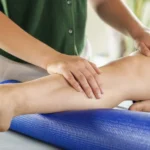Are you considering a career in massage therapy? If so, you may be wondering, “How long is massage therapy school?” Massage therapy school is a great option for those looking to pursue a career in the therapeutic bodywork industry. The length of massage therapy school varies depending on the program, but typically ranges from 500 to 1000 hours. In this article, we will discuss the various components of massage therapy school and how long it typically takes to complete the program. We will also provide some helpful tips for unlocking your future in massage therapy.
What is Massage Therapy?
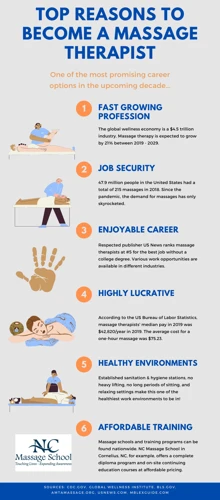
Massage therapy is a holistic practice that uses manual techniques to promote relaxation, encourage healing, and improve overall wellbeing. It is often used to treat physical and mental stress, reduce muscle tension, and promote circulation. Massage therapists use a variety of techniques, including Swedish massage, deep tissue massage, myofascial release, and Thai massage, to create customized plans for each client. The length of a massage therapy session may vary depending on the individual and their needs.
Massage therapy is a rewarding career and can be a great way to help people feel better and reduce stress. With the right education and training, you can become a massage therapist and unlock your future. If you are interested in becoming a massage therapist, you should consider how long it takes to complete massage therapy school.
How Long is Massage Therapy School?

Massage therapy school typically takes between 500 and 1000 hours to complete. This involves classroom instruction, hands-on practice, and an externship. Depending on the program, students may also have to complete additional coursework and exams to obtain licensure.
Here is a breakdown of the different types of massage therapy training:
- Classroom Instruction: This typically takes 600-700 hours.
- Hands-On Practice: This typically takes 200-400 hours.
- Externship: This is usually a 40-hour minimum requirement.
In addition to the classroom and hands-on experience, students may have to complete additional coursework and exams to get a massage therapy license. The coursework and exams vary depending on the state or province, but typically include anatomy, physiology, pathology, and business courses. The amount of time required to complete these courses can range from a few weeks to several months.
For those wondering how long it takes to get a massage therapy license, the answer depends on the type of program and the state or province you live in. Generally, it takes between 500 and 1000 hours to complete the necessary coursework and exams for licensure. However, the time frame can vary depending on the individual and the type of program they choose.
If you are considering a career in massage therapy, it is important to research your options and make sure you are taking the right steps to get the license you need. With the right program and dedication, you can unlock your future and become a certified massage therapist.
What Are the Requirements for Becoming a Licensed Massage Therapist?
To become a Licensed Massage Therapist (LMT), you must complete an accredited massage therapy program and pass a licensing exam. The licensing exam tests your understanding of different massage techniques and knowledge of anatomy and physiology. Generally, massage therapy programs range from 500 to 1000 hours, depending on the state. To be eligible to take the licensing exam, you must have completed your massage therapy program and be at least 18 years old.
You must also have a high school diploma or the equivalent, and pass a background check. Some states and jurisdictions may also require CPR and First Aid certification, in addition to completing a massage therapy program and passing the licensing exam.
The length of massage therapy school and the exact requirements to become a Licensed Massage Therapist vary by state. However, investing in a massage therapy education can open the door to a rewarding career. After completing your massage therapy program and receiving your license, you can start to practice and gain experience as a massage therapist.
How Long Does it Take to Become a Massage Therapist?

Becoming a massage therapist typically requires a minimum of 500 hours of training, although some states may require additional hours. To put that into perspective, 500 hours is equivalent to 20 weeks of full-time study or 40 weeks of part-time study.
The exact length of study depends on how many hours of massage school you complete:
- Full-time students may complete their training in as little as 10 weeks.
- Part-time students may take up to a year or more to complete their training.
The amount of time it takes to become a massage therapist also depends on the type of program you choose. Most massage therapy schools offer both diploma and certificate programs. Diploma programs are typically more comprehensive and take longer to complete than certificate programs.
In addition to classroom instruction, most massage therapy programs require students to complete a certain number of supervised clinical hours. This allows students to gain hands-on experience and learn from real-world scenarios. The amount of clinical hours required varies from program to program, but typically ranges from 100-300 hours.
Once you have completed your training, you may need to pass a state or national exam to become a licensed massage therapist. Depending on the state, you may also need to complete continuing education courses to maintain your license.
Ultimately, the amount of time it takes to become a massage therapist depends on the type of program you choose and the number of clinical hours you complete. While it typically takes around 500 hours of training to become a massage therapist, some students can complete their training in as few as 10 weeks.
In summary, the answer to the question ‘How many hours is massage school?’ is 500 hours, but the actual amount of time it takes to become a massage therapist can vary.
What is the Curriculum of Massage Therapy School?
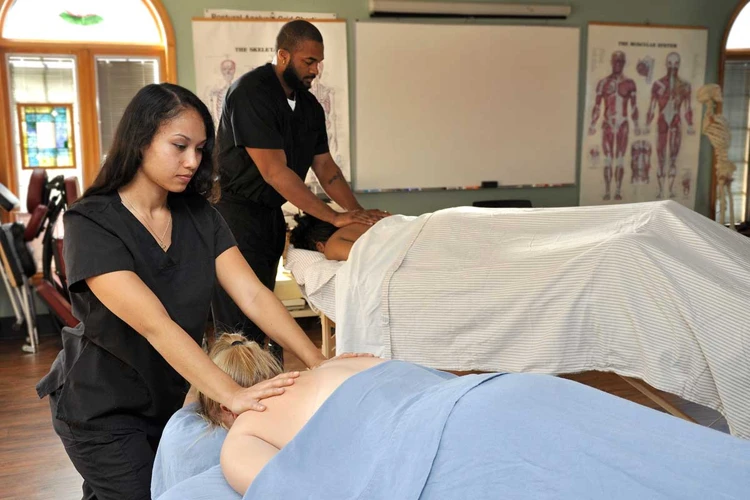
Massage therapy schools offer comprehensive, in-depth skills training in anatomy and physiology, massage therapy and bodywork techniques, professional ethics, and business practices. Students learn how to use massage to help treat clients with a variety of medical and emotional issues, while also developing their own practice. The curriculum typically includes the following topics:
Anatomy and Physiology: Understanding the structure and function of the human body is essential to becoming a successful massage therapist. Courses include instruction on the muscular, nervous, endocrine, cardiovascular, lymphatic, and reproductive systems.
Massage Therapy and Bodywork Techniques: Students learn a variety of massage techniques, such as Swedish massage, deep tissue massage, lymphatic drainage, and trigger point therapy. Courses also cover the use of hydrotherapy, aromatherapy, and other types of bodywork.
Professional Ethics and Business Practices: Students gain an understanding of legal, ethical, and safety issues related to massage therapy, as well as the practical aspects of running a massage business, such as marketing and client management.
Pathology: This course provides an overview of common medical conditions and how massage can be used to treat them. Students learn about various types of injuries, illnesses, and disabilities, as well as how to modify massage techniques to safely and effectively treat them.
What is the Cost of Massage Therapy School?
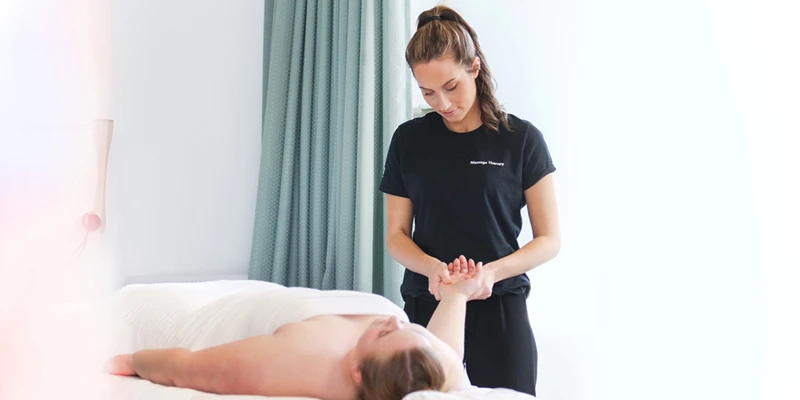
The cost of massage therapy school varies depending on the program and institution you choose. Programs may range from $10,000 to $20,000, with additional costs for textbooks, materials, and supplies. Most massage therapy schools offer financial aid to help cover the cost of tuition.
| Program | Cost |
|---|---|
| Diploma Program | $10,000 – $20,000 |
| Associate’s Degree | $10,000 – $20,000 |
| Bachelor’s Degree | $15,000 – $25,000 |
The cost of tuition for a massage therapy school typically includes fees for registration, tuition, and laboratory fees. It may also include costs for textbooks, supplies, and other materials. Additionally, most massage therapy schools require students to purchase their own massage table.
At most massage therapy schools, students can apply for financial aid, such as grants and loans, to help defray the cost of tuition. It’s important to research the different types of financial aid available and explore all options to make massage therapy school more affordable.
What are the Benefits of Becoming a Massage Therapist?
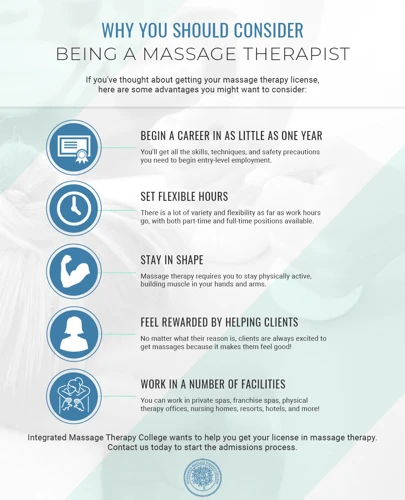
- Flexible Schedule: As a massage therapist, you have the freedom to set your own hours, making it easy to work around your other commitments.
- Make a Difference: Massage therapists help to reduce stress and pain, increase circulation, and improve posture, which can make a huge difference in the lives of their clients.
- High Demand: Massage therapy is a growing field, with the demand for massage therapists increasing as more people realize the benefits of massage.
- Good Pay: Massage therapists can earn good money, with the potential to increase their income with experience and additional certifications.
- Variety: Massage therapists can specialize in different types of massage, such as deep tissue, sports, and Swedish massage, providing variety and challenges in their work.
- Be Your Own Boss: Massage therapists can choose to work for themselves, setting their own hours and rates, and being their own boss.
What Kinds of Jobs Can a Massage Therapist Get?
Massage therapists are highly sought after in the wellness and beauty industry. With the right massage therapy school training and license, you can unlock a wide range of career opportunities. Massage therapists are employed in a variety of settings, from spas and resorts, to hospitals and clinics. Massage therapists can also work independently, setting up their own practices or joining an existing massage clinic.
Massage therapists work with clients to provide a variety of massage techniques, such as Swedish massage, deep tissue massage, sports massage, reflexology, and more. Massage therapists can also specialize in helping clients with medical conditions, such as chronic pain and arthritis.
Massage therapists must complete the necessary education and training to become licensed. Depending on your state, massage therapist schools may offer courses that last anywhere from 300-1,000 hours. To maintain a massage therapy license, you must also complete continuing education courses.
With the right massage therapy school training and license, you can unlock a wide range of job opportunities. Massage therapists are in demand in hospitals, clinics, spas, resorts, and more. With the right experience and qualifications, you can also work independently, setting up your own practice or joining an existing massage clinic.
So, if you’re looking to break into the massage therapy field, consider researching how long it takes to become a massage therapist. With the right massage therapy school and license, you can unlock a rewarding and fulfilling career.
Frequently Asked Questions
What Types of Massage Therapy Programs are Available?
Certificate Programs: These programs offer basic knowledge and skills required to practice massage therapy and last between 3-6 months.
Associate’s Degrees: These two-year programs provide students with a comprehensive education in massage therapy and anatomy and physiology.
Bachelor’s Degrees: These four-year programs provide students with a comprehensive understanding of massage therapy and anatomy and physiology, and the opportunity to specialize in a particular area of massage therapy, including sports massage, deep tissue massage, and medical massage.
Master’s Degrees: These programs are more advanced than bachelor’s programs and focus on a specific area of massage therapy. They often include additional courses in business, marketing, and management.
Is Massage Therapy School Expensive?
Massage therapy school can be expensive depending on the program and its duration. Most massage therapy schools charge a tuition fee plus additional expenses such as books and supplies. Many schools also offer financial aid packages to help offset the cost. Additionally, there are a variety of scholarships, grants, and other forms of assistance available to those pursuing massage therapy training.
What is the Typical Curriculum of a Massage Therapy Program?
Massage therapy programs typically involve the study of anatomy and physiology, massage theory and technique, and business and ethics courses. Students typically gain knowledge and skills in bodywork modalities, such as Swedish massage, deep tissue massage, and sports massage.
- Anatomy and Physiology – Students learn about the human body, including its structure and systems, and how to apply massage therapy to each system.
- Massage Theory and Technique – This provides students with a comprehensive understanding of massage by studying its history and practice, as well as manipulation of muscle and connective tissue.
- Business and Ethics Courses – These courses provide students with the skills needed to build and operate a successful massage therapy practice, such as market research, record keeping, and client assessment.
- Bodywork Modalities – Students receive instruction in various massage techniques, such as Swedish massage, deep tissue massage, and sports massage.
Massage therapy programs typically include hands-on training in the form of practice sessions with clients in a supervised clinical setting. This allows students to put their theoretical knowledge into practice and gain experience working with clients.
Are there any special qualifications required to attend massage therapy school?
Most massage therapy schools require applicants to have a high school diploma or GED equivalent and a certificate or degree in anatomy and physiology. Some schools may also require applicants to pass a background check, as massage therapists must maintain strict professional standards. Additionally, applicants must possess the physical and mental ability to perform massage therapy and other related duties.
How Long is the Process of Becoming a Licensed Massage Therapist?
Becoming a licensed massage therapist typically requires completing a massage therapy program from an accredited school. The length of the program can vary from state to state and from school to school, but on average it takes between 500 to 1000 hours of coursework, hands-on training, and practical experience. After completion of the program, applicants must pass a licensure exam in order to become a licensed massage therapist. Depending on the state, the exam may be administered by the state board of massage therapy or a third-party agency. Once the exam is passed and the license is obtained, massage therapists can practice their profession.
Conclusion
Massage therapy school is a great way to learn a valuable skill and pursue a rewarding career. With a variety of program lengths and options, there is something to fit everyone’s needs. A massage therapist can expect to be well-compensated for their services, so investing in massage therapy school is a smart move. With the right training and dedication, individuals can unlock the potential of a promising future in massage therapy.
References
- American Massage Therapy Association – Becoming a Massage Therapist
- Massage Therapy – School Requirements and Options
- Wikipedia – Massage Therapy



